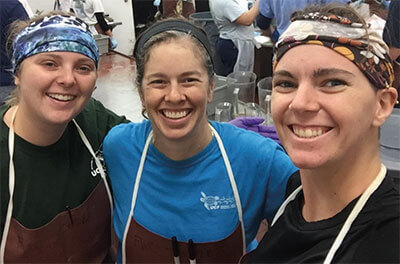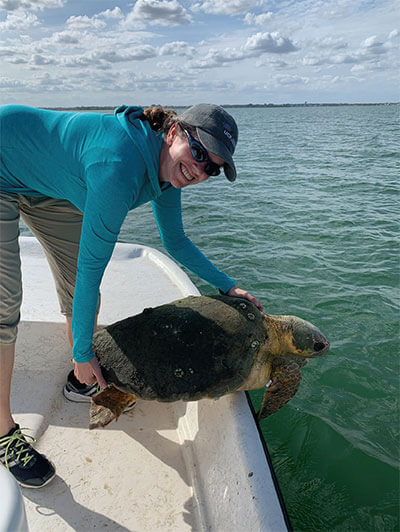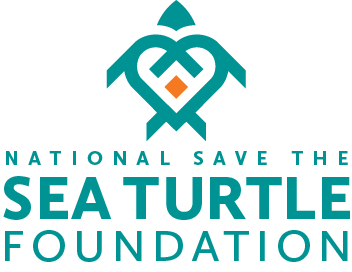What’s in a Diet? An Interview with Dr. Erin Seney, Assistant Research Scientist, University of Central Florida
Larry Wood, Ph.D.
Hello Erin! I’ve always been facinated by your work, how did you originally become interested in studying sea turtles?
As a kid, I loved visiting the turtles in a neighborhood pond, and I also liked the ocean. In high school, I was able to volunteer at a small aquarium and later had the opportunity to work with and study sea turtles in graduate school. I have been very fortunate to combine my interests in turtles and the ocean into a career working on sea turtles.
Your studies often explore what sea turtles eat. Though there is some overlap, it seems that most species have their own specialized diet. Can you help explain how these differences may have evolved?
Sea turtle diets are very diverse. There are species that largely consume plants (green turtles), sponges and corals (hawksbills), bottom-dwelling invertebrates (loggerheads and Kemp’s ridleys), and gelatinous animals like jellyfish (leatherbacks). These specializations likely evolved along with the species’ habitats and need to have a unique enough “niche” to survive alongside other organisms in those environments. The level of specialization among sea turtle species is reflected in their different head and beak shapes, as well as their digestive tract anatomy.
Given these semi-specialized diets, how impactful might different sea turtle species be on their respective environments?
Sea turtles can impact their environments in several ways through their feeding habitats. Consumption of a particular food item has impacts on the entire food chain, including not only the population of plant or animal that was eaten, but also other species that may compete for the same foods. Some animals may change their behavior to reduce the chance of being eaten or shift to other food items that are more readily available to them. Sea turtle foraging may also change the structure of the habitat, either by removing portions of stationary habitat features, such as seagrasses, sponges, and corals, or by digging into the seabed for food. Additionally, sea turtles circulate nutrients within the marine system by digesting food and excreting waste; this may be locally or over larger distances when individuals transition to new habitats or undertake seasonal migrations.
I see you’ve worked extensively with the Kemp’s Ridley sea turtle. Can you tell us a little about this species and why you decided to work with them?

I met my first Kemp’s ridleys while I was a master’s student in Virginia, where I studied their diets alongside that of the more-abundant loggerhead. There are important nearshore areas for Kemp’s ridley juveniles along the U.S. Atlantic coast, including the Chesapeake Bay, but Kemp’s ridleys are primarily found in the Gulf of Mexico, and I moved to Texas to study them for my Ph.D. The Kemp’s ridley is the smallest sea turtle species and has the smallest range of any species that occurs in the U.S. They reach a shell length of about two feet and weights up to about 100-120 pounds. Kemp’s ridleys are also one of the most conservation dependent species and were very close to extinction in the 1980s. Thanks to conservation and management efforts by Mexico and the U.S., the species has rebounded, but it remains endangered. I chose to study Kemp’s ridleys for my Ph.D. to learn more about their in-water biology and threats they experience, and I was able to satellite track nesting females from the upper Texas coast, as well as younger ridleys that were accidentally caught at local fishing piers. The Kemp’s ridley also has a personal appeal to me, in that they are small, tough, and feisty!
What techniques do you use to determine the diets of your research subjects?

Dr. Seney (center) and her most recent (June 2019)
necropsy session sampling crew (photo credit to Sarah Shaver,
UCF MTRG, selfie)
necropsy session sampling crew (photo credit to Sarah Shaver,
UCF MTRG, selfie)
The primary method I have used to study sea turtle diet is collecting and examining the gut contents of dead stranded sea turtles. While the death of any sea turtle is an unfortunate event, I have strived to help get the most information possible out these dead animals. In Virginia, my colleagues and I conducted necropsies (animal autopsies) of loggerheads and Kemp’s ridleys and collected all of the contents of the digestive tracts, which I later washed in a sieve and then identified visually. In Texas, live ridleys under observation after being accidentally hooked on fishing gear typically left me a sample in their tank; because ridleys eat mostly hard prey like crabs and snails, not everything they eat is digested and their poop is full of information about what they ate! More recently, I have been able to collaborate with the Florida Fish and Wildlife Conservation Commission and National Marine Fisheries Service to collect gut content samples from stranded loggerheads, Kemp’s ridleys, and green turtles from Florida and the northern Gulf of Mexico. For the loggerheads and ridleys, most prey identifications are done visually, and I have had a wonderful crew of past UCF Marine Turtle Research Group interns who have helped collect data. Green turtle samples, typically full of algae and/or seagrass, require a slightly different approach using microscopes to more closely examine the samples and cutting algae into sections to look at their cell structures to better identify species. I am still learning but have been fortunate to have the help of a colleague who is an expert on green turtle diet. I am also collaborating with a UCF colleague and one of her students to develop a molecular technique for characterizing green turtle diet, which will allow us to better identify food items using DNA sequencing.
How will the data you collect be used? Do you have hypothesis-driven research or are the data mostly descriptive?

Dr Seney releasing a loggerhead turtle. Photo credit goes
to Chris Long, UCF MTRG, and permits are NMFS 19508
and FWC MTP-231.
to Chris Long, UCF MTRG, and permits are NMFS 19508
and FWC MTP-231.
Characterization of sea turtles’ diet provides valuable information on their habitat, ecosystem role, and potential for interaction or competition with human activities. At the root of all of my diet research is the question “what do sea turtles eat?” but more specifically, I seek to better understand what different species eat in different locations, at different turtle sizes, and during different periods of time. This information fills gaps in our understanding of sea turtles and allows for better management of these protected species and the habitats they rely on. Diet research may also identify threats, such regions where sea turtles feed heavily on discarded fish from human fishing activities, which puts turtles at risk of entanglements, drowning, and boat strikes. With the larger sets of samples I have available for Florida and building on my existing knowledge from past studies, my students and I have started to ask more targeted research questions and make hypotheses about differences in a species’ diet in geographic regions or at different life stages. Recent student projects have examined the diets of turtles with different causes of death and the occurrence of fish in diets in the northern Gulf of Mexico. While we are interested in describing the diets of each species as a whole, it is really a moving target over space and time, so I hope to continue diet research over the long-term and continue to integrate other data, such as necropsy findings, with diet results.
Do you have other research interests you are also pursuing?
I am involved in several other research projects within the UCF Marine Turtle Research Group, including the lab’s long-term research and monitoring programs on central and southern Brevard County, Florida nesting beaches and in the central Indian River Lagoon. I am also involved in several collaborative projects related the movements, distribution, and ecology of smaller, oceanic-stage sea turtles in the Gulf of Mexico. Another newer project I am involved in, which is an offshoot of my diet research, is working with a UCF colleague to characterize the gut bacteria of sea turtles and examine connections to health and disease.
Do have any advice for young people considering a career in biology?
I would urge anyone considering a career in biology to explore things they are curious about by getting outside, visiting parks, aquariums, gardens, and museums (in person or virtually!), and taking advantage of public or online science events. It’s also important to ask questions and not be afraid to make mistakes – biology, like all sciences, is a learning process, driven by the urge to know more and address challenges. I would also urge them to broadly explore (and eventually study) a wide range of science and math-related fields. As a marine and conservation biologist studying sea turtles and working with diverse collaborators, I often need to think about oceanography, geology, physics, math, and statistics alongside ecology and biology.
Thanks Erin! Your work is really fascinating! Best of luck, and hope to see you at a conference soon!
Helping Sea Turtles Survive for 38 Years
A NON-PROFIT ORGANIZATION
State of Florida Registration Number CH-2841 | Internal Revenue Code 501 (c) (3)
Web Design & Development by Web Expressions, LLC

